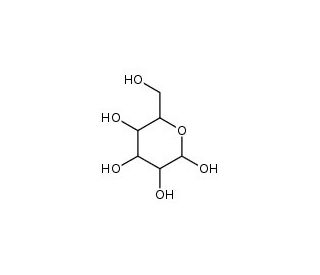

β-D-Glucose の分子構造、CAS番号: 492-61-5
β-D-Glucose (CAS 492-61-5)
別名:
Glucose; β-Dextrose; Glucoside
アプリケーション:
β-D-Glucoseはタンパク質の生産と脂質代謝に重要である
CAS 番号:
492-61-5
純度:
>80%
分子量:
180.16
分子式:
C6H12O6
試験・研究用以外には使用しないでください。 臨床及び体外診断には使用できません。
* Refer to Certificate of Analysis for lot specific data.
クイックリンク
注文情報
説明
技術サポート情報
安全情報
SDSと分析証明書
β-D-グルコースは、それ以上分解されないことで知られる単糖だが、還元性を示し、他の分子を還元することができる。この驚くべき分子は、様々な生化学的経路において重要な役割を担っており、科学研究において広く関心を集めている。解糖とペントースリン酸経路への関与は、代謝の研究において不可欠な要素となっている。さらに、細胞エネルギーの重要な供給源として、β-D-グルコースはエネルギー生産の研究に応用されている。炭水化物代謝や遺伝子発現制御の研究も、β-D-グルコースの利用から恩恵を受ける。還元糖として他の分子に電子を供与し、多様な生化学経路における還元反応を促進する。さらに、この万能分子は細胞のエネルギー源として機能し、代謝を受けて重要なエネルギー備蓄を生成する。β-D-グルコースは、その多面的な役割を通して、複雑な生物学的プロセスの理解を深め続けている。
β-D-Glucose (CAS 492-61-5) 参考文献
- Penicillium amagasakienseグルコース酸化酵素の保存されたアルギニン516は, β-D-グルコースの効率的結合に必須である。 | Witt, S., et al. 2000. Biochem J. 347: 553-9. PMID: 10749686
- 可溶性キノタンパク質グルコースデヒドロゲナーゼによるβ-D-グルコースの酸化反応における, Ca2+アシスト, 直接ヒドリド移動, およびC5還元PQQのPQQH2への律速的互変異化。 | Dewanti, AR. and Duine, JA. 2000. Biochemistry. 39: 9384-92. PMID: 10924133
- β-D-グルコースを足場としたライブラリーの効率的, 位置選択的, 立体選択的な開発。 | Hirschmann, R., et al. 2000. J Org Chem. 65: 8307-16. PMID: 11101390
- α-シクロデキストリン鋳型分子を用いた電気化学的に不活性なβ-D(+)-グルコースの電気化学センサー。 | Choi, SJ., et al. 2002. Anal Chem. 74: 1998-2002. PMID: 12033298
- β-D-グルコースおよびβ-D-キシロースの酸性水溶液中での分解機構の第一原理分子動力学シミュレーション。 | Qian, X., et al. 2005. Carbohydr Res. 340: 2319-27. PMID: 16095579
- β-D-グルコースで安定化された金ナノクリスタルの簡便な「グリーン」合成, 特性評価および触媒機能。 | Liu, J., et al. 2006. Chemistry. 12: 2131-8. PMID: 16358347
- 酸触媒によるβ-D-グルコースから5-ヒドロキシメチルフルフールへの変換機構とエネルギー論。 | Qian, X. 2011. J Phys Chem A. 115: 11740-8. PMID: 21916465
- メカニカルミリングによる結晶性グリセオフルビンの固体ガラス化。 | Willart, JF., et al. 2012. J Pharm Sci. 101: 1570-7. PMID: 22252982
- Rhodothermus marinus由来好熱性4-O-β-D-マンノシル-D-グルコースホスホリラーゼの特性解析。 | Jaito, N., et al. 2014. Biosci Biotechnol Biochem. 78: 263-70. PMID: 25036679
- α-およびβ-D-グルコースの立体化学において分子内水素結合は重要な役割を果たしているか? | Silla, JM., et al. 2014. Carbohydr Res. 396: 9-13. PMID: 25079595
- 高性能ナノセンサーを目指した様々な基板上での3次元Ni(OH)2およびNiOナノウォールの制御可能な合成。 | Li, G., et al. 2015. Small. 11: 731-9. PMID: 25273523
- D-グルコースオキシダーゼを用いたD-グルコースおよびそのアノマーの微量測定におけるムタロターゼの効果。 | Okuda, J. and Miwa, I. 1971. Anal Biochem. 43: 312-5. PMID: 5130408
- 潜在的な抗糖尿病薬の設計:グリコーゲンホスホリラーゼの多くのβ-D-グルコースアナログ阻害剤の実験的検討。 | Oikonomakos, NG., et al. 1994. Eur J Drug Metab Pharmacokinet. 19: 185-92. PMID: 7867660
注文情報
| 製品名 | カタログ # | 単位 | 価格 | 数量 | お気に入り | |
β-D-Glucose, 10 g | sc-291973 | 10 g | $95.00 | |||
β-D-Glucose, 25 g | sc-291973A | 25 g | $120.00 | |||
β-D-Glucose, 100 g | sc-291973B | 100 g | $200.00 |
